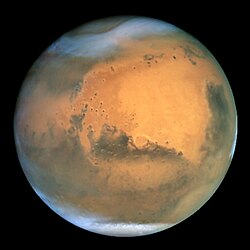Lyot (krater)
- För andra betydelser, se Lyot.
| Marskrater | |
|---|---|
| Lyot | |
 | |
| Egenskaper | |
| Koordinater | 50.47˚ N, 29.34˚ V |
| Medeldiameter | 221.53 km |
| Uppkallad efter | Bernard Lyot |
| Mars - ( ) | |
Lyot är en nedslagskrater på planeten Mars namngiven efter den franske astronomen Bernard Lyot.
Kratern har en diameter på ungefär 221 km.
Se även
Källor
- ”Lyot on Mars” (på engelska). International Astronomical Union. 17 november 2010. https://planetarynames.wr.usgs.gov/Feature/3538. Läst 13 november 2023.
| ||||||||||||||||||||||||||||||||||||||||||||||||||||||||
Media som används på denna webbplats
NASA's Hubble Space Telescope took the picture of Mars on June 26, 2001, when Mars was approximately 68 million kilometers (43 million miles) from Earth — the closest Mars has ever been to Earth since 1988. Hubble can see details as small as 16 kilometers (10 miles) across. The colors have been carefully balanced to give a realistic view of Mars' hues as they might appear through a telescope. Especially striking is the large amount of seasonal dust storm activity seen in this image. One large storm system is churning high above the northern polar cap (top of image), and a smaller dust storm cloud can be seen nearby. Another large dust storm is spilling out of the giant Hellas impact basin in the Southern Hemisphere (lower right).
Lyot crater, a relatively fresh peak ring crater on Mars. Mosaic of three Viking 2 images from camera A (675B16, 675B18, 675B20) and three from camera B (675B39, 675B41, 675B43). Minus blue filter was used for these images. All images were despeckled prior to mosaicing. North is at top.
Statistics below are for an average of the central two images:
Emission Angle: 11.5
Incidence Angle: 74.3
Latitude: 50.3
Longitude: 27.0


